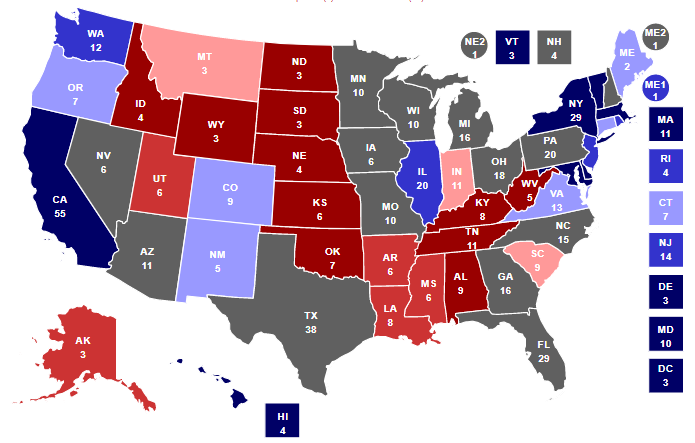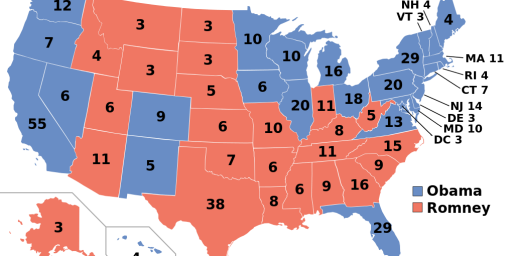Thinking About an EC/Popular Vote Inversion
Our screwy electoral system requires thinking about screwy scenarios.

Political Scientists Jonathan Cervas and Bernard Grofman* have a piece at Medium that asks: How Likely is Trump to Lose the Popular Vote but Win the Electoral College? They do some statistical analysis of past elections and come to the following conclusion:
When one candidate wins with just barely more than 50% of the vote, the probability of inversion is over 40%. However, when one candidate wins more than 52% of the two-party vote, the probability of inversion is effectively zero.
(All emphases in quotes are theirs).
Note they are talking about the two-party vote, and not the overall vote. Clinton won 51.1% of the two-party votes in 2016.
In 2016, Clinton lost the Electoral College despite winning nearly 3 million more than her opponent; 51.1% of the two-party vote. However, our simulations tell us that the inversion was not inevitable. In 44.3% of our simulations, Clinton won the Electoral College at her actual vote-share. In an election as close as 2016, we would normally expect about 21.8% to result in an inversion. Clinton’s inversion probability was twice the historic average.
What this tells us is just how unusual 2016 was or, perhaps more accurately, how Trump really defied the odds to win (which is ironic given how poorly he did in the casino business).
They also went back to 2000:
The simulations for the year 2000 with Gore winning the popular vote by 547,398 resulted in an Electoral College win for Gore half of the time, with another 2.6% ending with an exact tie. Unlike in 2016 when the expected probability of inversion was one in twenty, we estimated that Gore would have been expected to lose in the EC about 45% of the time based on historical simulations. Electoral ties are also very likely when the margin of victory is that narrow, around 22% of the time at Gore’s popular vote. That the 2000 election resulted in an inversion should not have been surprising. Had Bush won the election by the same 547,398 vote difference, our simulations indicate that Gore would have been expected to win the Electoral College 35% of the time.
They go on to note that there is a partisan bias in the system that makes the inversion more likely for Democrats to experience than for Republicans (that is, the distribution of electoral votes in the states means that it is simply more likely that a Republican who wins the popular vote would also win the electoral vote in the a close race than the other way around).
In 2016, for example, had Trump instead won the popular vote by the same margin as Clinton did, our simulation tells us that the probability that he would have lost the Electoral College was essentially zero (1.4%).
We see this asymmetry even more clearly at the point where each candidate would have received the same number of votes. In 2016, with 50% of the vote we might expect each candidate to have an equal likelihood of winning the Electoral College vote, but at 50-50 Trump would have been expected to win 86% of the time.
What this boils down to for accessing the current race is that margin of victory is important for Biden to avoid an inversion. Again, if he can win 52% or more of the two-party vote, he is all but certain to avoid an inversion. For example:
Polls show that President Trump is very likely to lose the popular vote. The claim that Joe Biden could lose if he won 5 million more votes than Donald Trump is technically true but, for all practical purposes, it is false. If Joe Biden does win by 5 million votes, which would be an estimated two-party vote share of around 53.8%, and if the states kept the same relative ranking in Republican support levels in 2020 as they had in 2016, then our estimated probability of inversion is close to zero — 0.6%. The latest RealClearPolitics polling average (accessed August 22, 2020) has Biden winning by 7.6 points. If that number holds, it is virtually impossible for him to lose in the Electoral College. The geographic distribution of voters in 2020 is more likely to look like 2016 than 2000 or 2004. Based on the figure for 2016 we can see that if Biden wins a majority but his victory margin is not that big, Donald Trump is very likely to win the Electoral College. But, if Biden wins by more votes than did Hillary Clinton, then it is Joe Biden who is likely to be our next president.
So, our system with its current distribution of voters and electoral votes creates, as we knew, a system wherein for the Democrat to win office requires them to beat the Republican by more votes than is true in the reverse.
If this were a football game, the Dems would have to win by a FG to win the game, instead of by just scoring one more point than the Reps, but the Reps would win even if they didn’t score the most points.
Regardless, the key to avoiding the inversion is margin of victory, as that predicts state-leve outcomes.
This discussion also comports with this from Nate Silver earlier in the week:
Note that would be the margin of the popular vote overall and not just the two-party vote.
At the moment, the polling has Biden nationally at +7.5%. It hasn’t been below +6 since early June and hasn’t been below +5 since mid-April (when it even briefly dipped below +4).
So, while things like Covid-related turnout problems, mail-in-voting snafus, or a true October Surprise might yet derail the situation, the probabilities remain that Biden will be elected in November.
*Grofman is one of my A Different Democracy, co-authors.






Recently I did my own analysis that reached a similar conclusion. I went to the 538 averages and subtracted Biden’s current national lead from that of Hillary’s lead (2.1). I then subtracted that amount from his lead in all the battleground states. By that estimate, he loses the EC (though interestingly, by a smaller margin than Hillary; it had him winning WI and MI but losing PA). His popular vote had to be at least 2.5 to produce an electoral win.
Character on my new favorite show Barry: “you know what Thomas Friedman, you’re bad at writing and nobody likes you.”
Gonna go down in the weeds…
How the change in national percentage gets mapped onto states is incredibly important here. More people voted for Trump in California than in all but two of the states he won. If the national popular vote swing is happening largely in states that Clinton won, it has a much smaller impact on the EC outcome.
A concrete example. Split the country into three regions: the 13-state West, the 12-state northeast urban corridor, and the 25-state Rest. Ignoring the faithless-elector and by-district weirdnesses, Clinton got 104 EC votes in the urban corridor, 98 EC votes in the West, and a miserable 30 in the Rest (the Rest accounts for about 55% of the US population). When you look at the House gains in 2018, just over two-thirds of them came from the West-plus-corridor states. Enough, in fact, to have won control of the House (in at least that sense, the Rest pickups were just gravy). If something over two-thirds of Biden’s national improvement over Clinton is in those regions where Clinton got her EC votes, most of that is wasted.
The Republicans have figured out that they can just write off entire sections of the country. They can lose California by 4 million votes. They can lose NYC by 1.7 million. As long as they 51% of the rest of the country, they can take the White House. The EC was fine for 200 years until the GOP figured out how to game it.
@Michael Cain:
But there’s no evidence that’s happening. There’s both good and bad news here. The bad news is that Trump’s EC advantage that he enjoyed in 2016 still seems to be in full force. The good news is that it doesn’t seem to have increased since 2016; it’s just at about the same level it was before. Despite speculation by some commentators that Trump could lose the popular vote by 5 points (or more!) and still win the EC, there don’t appear to be any signs of that. (And keep in mind, there were signs of Trump’s EC advantage in 2016–538 detected them as early as the summer.) So if Biden does significantly better in the popular vote than Clinton, he’s almost certain to win the EC. In theory, of course, he might win the popular vote by 5, 10, 20 or more points but because it’s all concentrated in Cali and NY, he still loses the EC–but the data just don’t support the idea that that’s anywhere close to happening.
If the northern border of Florida were moved south a few miles and the eastern border of Pennsylvania moved eastward 1 mile or so, Clinton would have won the presidency with ZERO people changing their votes.
That’s how screwed up the EC is.
@Hal_10000:
This, and part of that gaming is a move towards disenfranchisement through whatever means necessary. See for example what Former Secretary of State, now Governor, Kemp is accused of doing in Georgia (under his watch up to ~63% purged voters may have been wrongly removed from the polls ahead of an election he was running for Governor in):
https://www.ajc.com/politics/politics-blog/the-jolt-aclu-of-georgia-says-nearly-200k-voters-were-wrongly-removed-from-registration-rolls-in-2019/QOUK2FKOWZF6TGZOSDLHQGWHPM/
@Hal_10000: @mattbernius: It is less that the GOP can game the system (which, to me, implies finding a loophole or a means to subvert a process) than it is that the design itself has lead to a moment wherein one part gets a clear advantage without actually having to do anything.
@Steven L. Taylor:
Really important point, though I would say that the parenthetical is true as well. The design of the system, combined with the evolution of the United States, has created loopholes or unintended consequences that enable a party to subvert the original intent of the process along with the process itself.
The biggest story for me, is how the Republican Party itself has accepted that it can’t possibly capture the majority of the American voters, and is making absolutely no effort to do so or even argue the fact.
Instead they just think the problem is finding new ways to gain and keep power without the need of the support of the governed.
I still think that with Texas going blue we are more or less like to see GOP experiencing a popular vote inversion, and I confess that’s going to be fun.
@Steven L. Taylor:
I think it’s more that we got lucky. The problem in the EC was first stayed by segregation keeping many southern conservatives in the Democratic Party. And then it was stayed by a series of President who, whatever their flaws, wanted to be President for everyone. They all at least made a token effort to win every state. The GOP and Trump especially don’t care about such a broad appeal. Whatever they can do to get 50%+1 is good enough.
@mattbernius: Unintended consequences for sure. I am being pedantic because I think of “gaming” as requiring someone to be actively engaged in an activity while the GOP advantage in the EC is self-executing and requires nothing from the party for the party to get the advantage.
@Hal_10000:
Man, I wish that they actually had to work enough tp get 50%+1!
@Steven L. Taylor:
Got it. I guess my thought is, to Hal’s point, they still have to keep to 50%+1 in the various swing states they control, which is where the disenfranchisement strategies kick in (see FL as a particularly egregious example as of late).